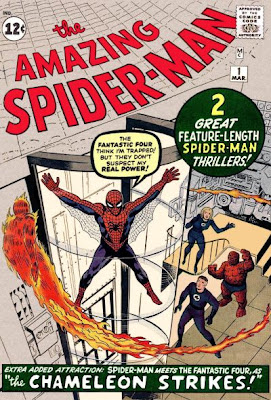"Spider-Man!"
Words by Stan Lee.
Art by Steve Ditko.
Lettering by Johnny Dee.
They knew how to pack things in in the old days. With this landmark issue, we get not one but two Spider-Man stories and, rarely for Marvel Comics of this era, not one of them features aliens. If I'm remembering right, the Hulk met aliens in his second adventure, as did the Fantastic Four, and Thor met them in his first. Here, Spider-Man does get to ride a rocket, as did the Fantastic Four, while Daredevil got to ride in one in his second issue, but our hero never quite makes it into space.
Already the effects of the Marvel Method are there to be seen. For anyone who doesn't know, the way it worked was that, instead of writing a full script for the artist to draw, Stan Lee would give an outline to the artist who'd go off and work out the details of the plot for himself. Lee would then, upon receiving the artwork, try to make sense of the story the pictures were telling him and add dialogue and captions to them. In some cases, he wouldn't even do that, he'd just say, "Jack/Steve, wouldn't it be a great if Antman grew two heads?" and then leave Jack/Steve to work out the story.
Here, we seem to get one of those occasions where the artist's idea of what's going on isn't quite the same as the writer's. I think, from looking at the pictures, that Steve Ditko's telling the tale of an out of control space capsule that can't land because its lost its parachute, which Spider-Man duly replaces by fixing a new one to the nose cone, thus saving the life of John Jameson; whereas Stan Lee's words tell of a missing part that's sent the capsule out of control and needs to be replaced before the capsule can release its parachute and land.
Either way, Spider-Man proves his mettle by doing the job. There's some insanely brilliant artwork here as Spider-Man stands atop a speeding jet and snags the hurtling capsule with his webbing. Overall, Ditko's work is stronger this issue than it was for Spider-Man's origin tale, an improvement that'd continue for a good two years beyond this point.
It has to be said there are some unlikely happenings in this tale. For a start we get to see a space rocket that seems to be launching from the middle of New York City. Clearly safety standards at NASA were a lot laxer in those days. We also get to see jets flying higher than a supposedly orbiting capsule, and Spider-Man having no difficulty breathing miles above the Earth's surface.
And, as for the capsule landing on solid ground. Ouch!
Words by Stan Lee.
Art by Steve Ditko.
Lettering by John Duffi.
So, we've had the, "Our hero gets to ride on a space rocket," motif, now we get that other Stan Lee favourite of the age, "Master of disguise frames our hero." It happened to the Fantastic Four in their second outing, with the skrulls, and now it happens with Spider-Man and the Chameleon.
It has to be said it's a more mundane tale than the one the Fantastic Four endured. Being just a bloke with a bunch of masks, the Chameleon doesn't quite have the glamour of the skrulls but it is a chance for Spider-Man to show off what he can do, making full use his spider-sense to locate the villain's helicopter. Even though this tale appears to be the first time he's ever used it, somehow the Chameleon knows all about it and how to use it to contact him.
He also shows off his ability to whip up a parachute and to operate in the dark.
He does, as well, something I'm not sure he ever did again, where he effectively flies by creating a web catapult to send himself soaring into the air. It seemed to be de rigueur for Marvel heroes at that stage to be able to "fly" in some way, whether it be via the Torch's flame or Thor's hammer or the Hulk's leaping. Any old excuse to get them airborne seemed good enough.
But, nefarious as he is, the Chameleon's really just a sideshow. The real point of this story is, of course, Spider-Man's battle with the Fantastic Four, clearly thrown in to get readers of that mag to pay up for this one. And it's nice to see Spider-Man more than holds his own against them. It's the first time we've really got a sense of his full power and potential. Here he is fighting Marvel's mightiest heroes, including the Thing, to a standstill.
Despite his secret identity, our hero turns up at the Baxter Building, for his, "audition," in his Peter Parker guise. Someone ought to tell him that's not exactly the best way to preserve a secret identity.
We're told Spider-Man's wanted by the police. For what exactly, isn't clear.
On the art front, this story has a great splash page, with Spider-Man firing his webbing at a giant version of the Chameleon who looms like the Shadow over the skyscrapers of New York as the FF watch on. Not a natural super hero artist, Ditko's work seems to be getting more and more stylish as he goes along.



















.jpg)















2 comments:
I love that the FF are offered as an EXTRA BONUS EXTRA!!
Stan never believed in under-selling a tale did he?
Post a Comment